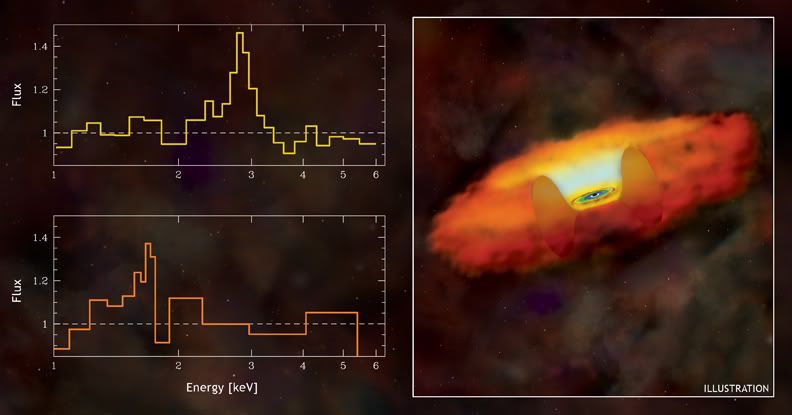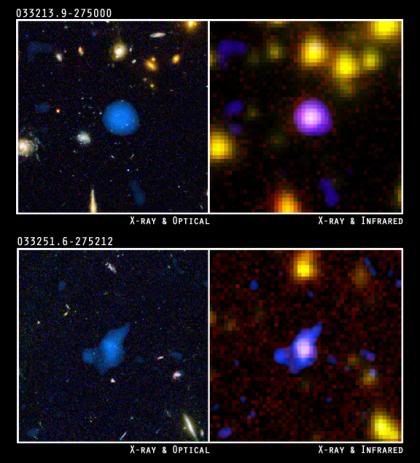To: rahbert
Using Chandra spectra obtained from more than 300 supermassive black holes in the centers of galaxies, a team of astronomers has been able to determine the amount of iron near the black holes (light blue in illustration on the right). The black holes were all located in the North and South Chandra Deep Fields, where the faintest and most-distant X-ray objects can be identified. The left side of the above graphic shows portions of X-ray spectra from a subset of 50 black holes about 9 billion light years away (upper panel), and another group of 22 black holes that are about 11 billion light years away (lower panel). The peaks in the spectra are produced by X-ray emission from iron atoms, and indicate that approximately the same amount of iron was present around black holes 9 billion years and 11 billion years in the past. Similar results corresponding to times ranging from 5 billion years to 9 billion years in the past show that the amount of iron around black holes has not changed significantly over the past 11 billion years. This implies that most of the iron in the galaxies that contain these supermassive black holes was created before the Universe was about 2 billion years old, when galaxies were very young. The distinctive X-ray spectral peaks are produced by the fluorescence of iron atoms in a doughnut-shaped torus orbiting a supermassive black hole. In this process, high-energy X-rays from hot gas very near the black hole excite the iron atoms to a higher energy state, and they almost immediately return to their lower energy state with the emission of a lower-energy, fluorescent X-ray.

16 posted on
01/05/2010 6:25:37 AM PST by
rahbert
(Bop Bop, dibidip dibidip....)
To: rahbert
The combined powers of three of NASA's Great Observatories -- the Hubble Space Telescope, the Chandra X-ray Observatory, and the Spitzer Space Telescope -- have been used to find evidence of a hidden population of supermassive black holes in the universe. All these space telescopes took a long look at a small region of the sky (called the Great Observatories Origins Deep Survey field, or the GOODS field for short). When visible light and X-ray light from this region were compared, astronomers found numerous X-ray sources that can be identified as supermassive black holes in young galaxies billions of light years from Earth. But the X-ray glow from other sources had no obvious host galaxies in optical light. Two of these X-ray sources are identified by the central blue spots in the composite Hubble-Chandra images on the upper and lower left panels. The Chandra-Spitzer composite X-ray/infrared images on the upper and lower right panels demonstrate that these mysterious sources are also detected at infrared wavelengths. This indicates that the galaxies around these supermassive black holes are heavily obscured by dust. Visible light is absorbed by the dust, which is heated by the absorption and glows at infrared wavelengths. Astronomers have suspected that many supermassive black holes may have been missed in optical surveys because they were shrouded in dust. Combined data from Chandra, Spitzer and Hubble should soon yield a much more complete census of the number of black holes in the early universe

17 posted on
01/05/2010 6:32:32 AM PST by
rahbert
(Bop Bop, dibidip dibidip....)
FreeRepublic.com is powered by software copyright 2000-2008 John Robinson


